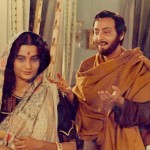Dir. by Satyajit Ray
Images: Film appears to be lit entirely by source lighting. Interiors are often very dark, reflecting the isolation and confinement within the inner sanctum of the estate. Memorable images include: profiles of faces lit by candlelight; Bimala pressed against the wall, staring ahead motionless (followed by dissolve into widow’s whites); crowds of young nationalists, lifting their fists and chanting, “Hail Motherland!”
• • •
In 1907, British rulers of India have partitioned Bengal, dividing the Muslims from the Hindus and silencing their collective political voice in the process. In response, Swadeshi, a burgeoning nationalist movement, demands a boycott of all British goods. We experience Swadeshi through the eyes of Bimala Choudhury (Swatilekha Chatterjee), a modern woman (she has been educated) married to a modern man. Nikhilesh (Victor Banerjee) is a wealthy land-owner who was educated in the West and who objects to the repressive treatment of Indian women. He allows Bimala unprecedented freedom, including freedom of movement around their estate, opportunities to meet other men, and English lessons. Against this modern relationship, Ray contrasts Bimala’s more traditional sister-in-law, a woman whose husband was unable to even recognize her face on his deathbed.
The first man Bimala meets is Sandip (Soumitra Chatterjee), a charismatic leader of Swadeshi and former classmate of Nikhilesh. Sandip has arrived in hopes of turning his old friend toward his cause, but Nikhilesh steadfastly refuses, much to his wife’s disfavor. Bimala is instantly taken by Sandip, a man of superficial passion. She is so moved by his zealous rhetoric that she becomes the first female member of Swadeshi. The two begin to meet privately, eventually striking up an affair. Nikhilesh is aware of their relationship, but refuses to intervene, preferring instead that his wife’s love be granted freely, even if to another man.
Bimala strikes me as an Indian equivalent of Lily Bart. Like Edith Wharton’s famous heroine, Bimala is allowed the freedoms of a modern woman, but lacks the experience and social context necessary to use it effectively. After spending the first decade of her marriage in isolation, forbidden from even seeing a man other than her husband, she is ill equipped to read Sandip’s hypocrisy. She mistakes his performed speeches for genuine passion, and suffers the consequences for her failing. For Ray, there are no simple solutions for the “woman problem”: the fate of Bimala’s sister-in-law is clearly not acceptable, but neither is Bimala’s.
In The Home and the World there are also no simple solutions to the complex legacy of British imperialism. Ray forces us to listen to several of Sandip’s speeches from start to finish. It’s an effective move, for his words resonate with some truth: by becoming dependent upon British goods, the people of India have surrendered economic clout and filled the pockets of Western manufacturers and importers. In so doing, they have also taken a significant step toward assimilation, internalizing a Western value system that diminishes their own cultural accomplishments and beliefs. Sandip’s chant, “Hail Motherland” (even with its frightening echoes of mid-century European nationalism) sent a chill down my spine like it did Bimala’s.
But we also see the other side of the issue through Nikhilesh, who refuses to support Swadeshi because of its untold economic consequences on the poor of Bengal. British goods are not only of better quality, but are cheaper; remove them from the local economy and the poor will be forced to buy less for their families and sell less in their markets. Like the manufactured goods sold (or burned) in Bengal’s markets, other British imports — including democracy, education, and greater freedom for women — must be acknowledged for the good and harm they have brought to the people of India.

Comments
One response to “The Home and the World (1984)”
Excellent review.